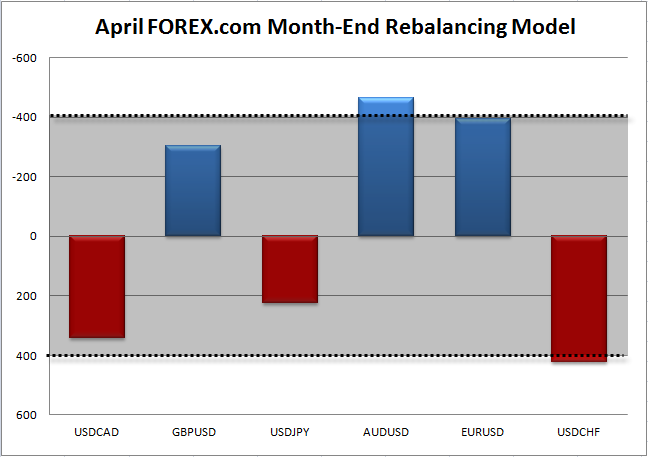April Month-End Model Hints At Possible USD Selling
Matthew Weller | Apr 27, 2015 09:11AM ET
Background:
Traders often refer the impact of ‘month end flows’ on different currency pairs during the last few days of the month. In essence, these money ‘flows’ are caused by global fund managers and investors rebalancing their currency exposure based on market movements over the last month. For example, if the value of one country’s equity and bond markets increases, these fund managers typically look to sell or hedge their now-elevated exposure to that country’s currency and rebalance their risk back to an underperforming country’s currency. More severe monthly changes in a country’s asset valuations lead to larger portfolio adjustments between different currencies.
In order to predict these flows and how they impact FX traders, we’ve developed a model that compares monthly changes in the total value of asset markets in various countries. In our model, a relative shift of $400B between countries over the course of a month is seen as the threshold for a meaningful move, whereas monthly changes of less than $400B are often overwhelmed by other fundamental or technical factors. As a final note, the largest impact from month-end flows is typically seen heading into the 11am ET fix (often in the hour from 10 and 11am ET) as portfolio managers scramble to hedge their overall portfolio ahead of the European market close.
As we enter the final week of April, it’s difficult to draw any strong conclusions about global market performance as a whole. Global equity indices were a mixed bag, with some markets edging higher (US indices, the FTSE, the CAC, the Nikkei and a few Asian bourses in particular), some unchanged (DAX and IBEX) and a few even edging lower (India’s Sensex). Bond yields were similarly nuanced, with the US and 10-Year yields essentially unchanged at 1.93% and 0.17%, respectively, while periphery European yields edged up on concerns about Greece and Japanese yields fell.
It’s at times like these where having a rigorous, objective process can help traders prepare for the impact of any month-end flows on the currency market. Our model shows that, on the whole, US capital markets generally outperformed their global counterparts, meaning that global portfolio managers will have to sell US investments and buy other assets to rebalance back to their target allocations. As a result, we could see some dollar selling heading into the middle of the week, though two factors suggest this month’s signal could be less impactful than usual. First, it’s important to note that of the six currency pairs we follow, only two (AUD/USD and USD/CHF) reach the +/- $400B signal that we consider significant. Beyond that, this month’s flows may be overwhelmed by the reaction to Wednesday and Thursday’s high-impact data onslaught (headlined by eurozone CPI, US GDP, and central bank meetings from the Fed, RBNZ, and BOJ).

Source: Forex.com

Trading in financial instruments and/or cryptocurrencies involves high risks including the risk of losing some, or all, of your investment amount, and may not be suitable for all investors. Prices of cryptocurrencies are extremely volatile and may be affected by external factors such as financial, regulatory or political events. Trading on margin increases the financial risks.
Before deciding to trade in financial instrument or cryptocurrencies you should be fully informed of the risks and costs associated with trading the financial markets, carefully consider your investment objectives, level of experience, and risk appetite, and seek professional advice where needed.
Fusion Media would like to remind you that the data contained in this website is not necessarily real-time nor accurate. The data and prices on the website are not necessarily provided by any market or exchange, but may be provided by market makers, and so prices may not be accurate and may differ from the actual price at any given market, meaning prices are indicative and not appropriate for trading purposes. Fusion Media and any provider of the data contained in this website will not accept liability for any loss or damage as a result of your trading, or your reliance on the information contained within this website.
It is prohibited to use, store, reproduce, display, modify, transmit or distribute the data contained in this website without the explicit prior written permission of Fusion Media and/or the data provider. All intellectual property rights are reserved by the providers and/or the exchange providing the data contained in this website.
Fusion Media may be compensated by the advertisers that appear on the website, based on your interaction with the advertisements or advertisers.